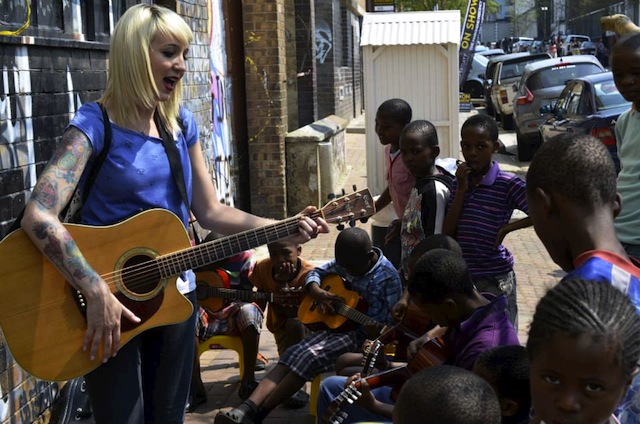
Hipster probably isn’t the first word you think of when you picture Johannesburg. While the city has a turbulent past that still affects the way people perceive it, Joburg is home to a number of neighborhoods with worthwhile offerings: Upscale shopping in Sandton, nightlife in Soweto, street art and heritage in Newtown, Mandela history in Rivonia, and, a neighborhood that reminded me of my home borough of Brooklyn: Maboneng.
Sitting on land that was where Johannesburg‘s first suburb sat, the neighborhood all started with the opening of Arts on Main in 2009. Arts on Main is a fair-like experience featuring studios, galleries, artisanal food vendors, vintage clothing vendors and tables of handcrafted accessories. As it grew into a popular social hub there became a need to expand the arts focus to something larger than a courtyard and building, but to an entire neighborhood that we now know as Maboneng, which means “place of light.”

Propertuity is the development company who took on the project, transforming this once dangerous inner city space into something welcoming, walkable, eclectic and community-driven. In Johannesburg, art was historically a foreign concept people didn’t understand, which is something Maboneng is quickly changing and people are happily embracing. In fact, the city now has a goal of being the world’s largest public art city by 2040, an aim Maboneng is fervently helping them to reach. What’s really interesting about the urban regeneration project is their approach, which is much different than most cities doing similar things.
“Propertuity believes in integration over gentrification,” explains Bheki, a guide for a walking tour company called Mainstreetwalks and concierge for Propertuity. “We only buy abandoned buildings. If it’s 30% or more occupied we won’t touch it.”
Walking down the main hub of Fox Street where Arts on Main is, it’s hard to believe there were once warehouses, piles of garbage and acts of xenophobia. Today, the scenic street is full of artisanal cafes advertising daily specials on chalkboards, al fresco eateries with wooden tables and wine glasses, locals skateboarding and cycling, experimental theaters, inspiring street art (including the international “Before I Die” wall), galleries and studio spaces churning out innovative creations.

For visitors, staying at the art and heritage-focused 12 Decades Hotel on Fox Street can immerse you in Maboneng’s philosophy. Along with offering themed galleries on each floor and a Pop Art Theatre, the property features 16 rooms and apartments, each designed by a different South African to represent a decade of South African history in a creative way. For example, “Vision — Main Street Life” replicates Johannesburg from 1886 to 1896 when wealthy Randlords inhabited the city through the furnishings, while design elements pay homage to the Chinese indentured laborers working in the local mines during that time. Moreover, the “Marabi” room takes you back to 1926-1936 when the Marabi dance movement was happening with antique fittings, a weathered dressing room door and sparkly dress hanging from the wall. The most interesting room in my opinion is the “A Part Love, A Part Hate” room that takes a tongue-in-cheek approach to Apartheid, especially with a toilet with the old Apartheid Laws written in it, allowing you to do your business right on them.

Another artistic attraction is the over 30 public works from local and international artists littered around the precinct (you can download a map at MabonengPrecinct.com). For example, while Michael Subotzky plays with textures, dimensions and reflections in “Main Street Life,” Freddy Sam expresses his ideas about the intersection between humans and nature in Drivelines.
And Maboneng isn’t done growing yet as it continues to propel into the future. Bheki himself is opening an arts hostel for backpackers called Curiocity in October 2013, which will offer dorms as well as urban camping on the rooftop. Also coming in October will be the Museum of African Design (MOAD), Africa’s first design museum focusing on everything from furniture to urban planning to general arts to architecture and beyond. These are just a few of the many ideas that are coming to life in Maboneng.

I feel right at home in this dangerous-hood-turned-hipster-haven. Propertuity — which owns 35 buildings and counting — is helping to change the way locals and visitors view Johannesburg and the inner city, allowing people to walk and explore freely without worry. I’m looking forward seeing how Maboneng continues to grow into the future and erases the idea that Johannesburg is too dangerous to visit.
Transportation Tip: No matter where you’re staying in Johannesburg you can visit the Maboneng Precinct via the Mabo’go (078 047 6812). This shuttle service picks you up from your home or hotel and brings you to Maboneng, giving you four hours to explore the neighborhood.
About The Author
Jessica Festa is the editor of Epicure & Culture as well as Jessie on a Journey. She enjoys getting lost in new cities and having experiences you don’t read about in guidebooks. Some of her favorite travel experiences have been teaching English in Thailand, trekking her way through South America, backpacking Europe solo, road tripping through Australia, agritouring through Tuscany, and doing orphanage work in Ghana.
Jessica Festa
Latest posts by Jessica Festa (see all)
- A Culturally-Immersive Adventure In Mongolia’s Altai Mountains - Jul 8, 2023
- This Recipe Sharing Platform Supports Women In The Culinary Industry (Labneh Recipe Included!) - Nov 5, 2020
- Hiking The Mohare Danda Community Eco-Trek In Nepal - Jun 3, 2020
- 6 Important Questions For Choosing A Responsible Yoga Retreat - May 18, 2020
- How To Create & Grow A Profitable Blogging Business (Ethically) - Jan 18, 2020




